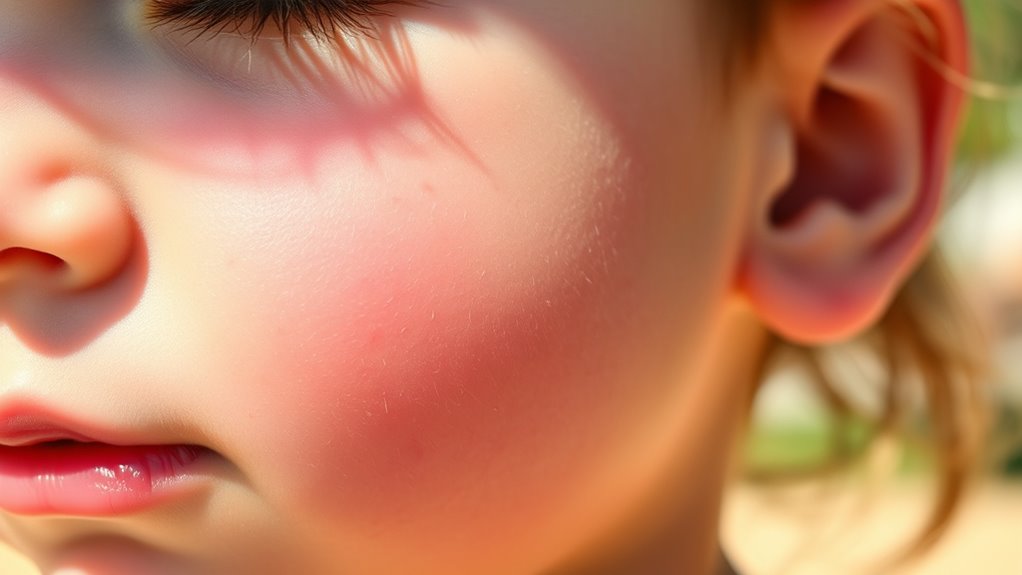Children’s skin is more vulnerable to UV damage because it’s thinner and more delicate than adult skin, making it easier for harmful rays to penetrate deeply. Young skin has less melanin, which provides some natural protection, so it’s more sensitive to sun exposure. Genetic traits like fair skin and light hair can increase this risk even more. To better understand how to keep their skin safe, keep exploring these important details.
Key Takeaways
- Children’s thinner, more delicate skin allows UV rays to penetrate more deeply, increasing damage risk.
- Higher sensitivity and genetic traits like fair skin reduce natural UV protection in children.
- Lower melanin levels in children’s skin provide less defense against harmful UV radiation.
- Children’s skin has fewer natural defenses, making it more vulnerable to immediate and long-term UV damage.
- UV exposure during childhood accumulates, heightening the risk of skin damage and skin cancer later in life.

Children’s skin is especially vulnerable to UV damage because it is thinner and more delicate than adult skin. This increased sensitivity means that harmful ultraviolet rays can penetrate more deeply, causing immediate and long-term damage. One reason for this heightened vulnerability is genetic susceptibility. Some children inherit genes that make their skin more prone to damage, reducing their natural defenses against UV radiation. If your child has fair skin, light hair, or a tendency to burn easily, their genetic makeup likely contributes to a higher risk. These inherited traits mean their skin produces less melanin, the pigment that provides some protection by absorbing UV rays. As a result, even brief sun exposure can cause damage that accumulates over time, raising the risk of skin issues later in life.
Understanding genetic susceptibility can help you be proactive in protecting your child’s skin. It highlights the importance of diligent sun safety practices, especially for children with these inherited vulnerabilities. One of the most effective tools you have is sunscreen. However, the effectiveness of sunscreen depends on proper application and choosing the right product. Children’s skin absorbs substances differently, and their thinner skin can make sunscreen less effective if not applied correctly. Applying a broad-spectrum sunscreen with at least SPF 30 generously and evenly to all exposed areas is crucial. You should do this about 15 minutes before going outside and reapply every two hours, or more often if your child is swimming or sweating.
It’s also important to remember that sunscreen isn’t foolproof. No product provides 100% protection, so combining it with other sun safety measures is essential. Seek shade during peak sun hours, typically between 10 a.m. and 4 p.m., and encourage your child to wear protective clothing, hats, and sunglasses. These steps work together to minimize UV exposure, which is especially essential given the heightened vulnerability of children’s skin. Additionally, advances in AI safety measures and continuous research can help develop better protective products and strategies in the future.
While sunscreen effectiveness can vary based on factors like product quality and application, consistent use substantially reduces UV damage risk. Because children’s skin is more delicate, any damage can have a more profound impact over time, increasing the likelihood of skin aging and skin cancer later in life. By understanding their genetic susceptibility and diligently applying sunscreen, you help safeguard your child’s skin now and in the future. Protecting their delicate skin from UV damage isn’t just about immediate comfort; it’s an investment in their long-term health.
Frequently Asked Questions
How Does Genetics Influence Children’s Skin Vulnerability to UV Rays?
Genetics play a big role in how your child’s skin reacts to UV rays. Genetic variations affect skin pigmentation, influencing how much melanin your child produces. More melanin offers better protection, while less makes skin more vulnerable. If your child has lighter skin or specific genetic traits, they’re at higher risk of UV damage. Understanding these genetics helps you take extra precautions, like applying sunscreen and keeping them in the shade.
Are Certain Skin Tones More Resistant to UV Damage in Children?
You might notice that children with darker skin tones often resist UV damage better due to increased skin pigmentation, which acts as a natural barrier. Coincidentally, this pigmentation provides some sun protection, reducing the risk of sunburns and long-term damage. However, regardless of skin tone, sun protection remains essential, as no skin is completely immune. Always encourage protective measures like sunscreen, hats, and shade for your child’s safety.
Can Early UV Exposure Affect Children’s Long-Term Skin Health?
Early UV exposure can considerably impact your child’s long-term skin health. It increases the risk of premature skin aging and skin cancer later in life. To protect your child, guarantee consistent sun protection like applying broad-spectrum sunscreen, wearing protective clothing, and seeking shade during peak hours. These habits help minimize UV damage, maintaining healthier skin and reducing the likelihood of long-term skin issues.
What Role Does Hydration Play in Protecting Children’s Skin From UV Damage?
Did you know that well-hydrated skin is 30% more resistant to UV damage? Hydration importance can’t be overstated, as it helps maintain skin moisture, which forms a crucial barrier against harmful rays. When children stay properly hydrated, their skin remains resilient, reducing the risk of sunburn and long-term damage. Encourage regular water intake and moisturizing routines to protect their delicate skin from UV harm effectively.
Are There Specific Ages When Children Become More Susceptible to UV Harm?
You should know that children become more susceptible to UV harm at certain ages due to age-specific vulnerabilities and developmental skin changes. Infants under six months have delicate, thin skin that offers minimal protection, making them especially vulnerable. As kids grow, their skin thickens, but during early childhood and adolescence, rapid development can temporarily increase UV sensitivity. Protecting children during these key stages helps prevent long-term skin damage.
Conclusion
Remember, your child’s skin is like a delicate flower, easily harmed by the sun’s rays. Because their skin is thinner and still developing, it’s more vulnerable to UV damage. Protecting them with sunscreen, clothing, and shade isn’t just smart—it’s essential. Think of it as shielding a precious gem from harsh sunlight. By taking these steps, you help keep their skin healthy and strong, allowing them to enjoy sunny days without worry.









